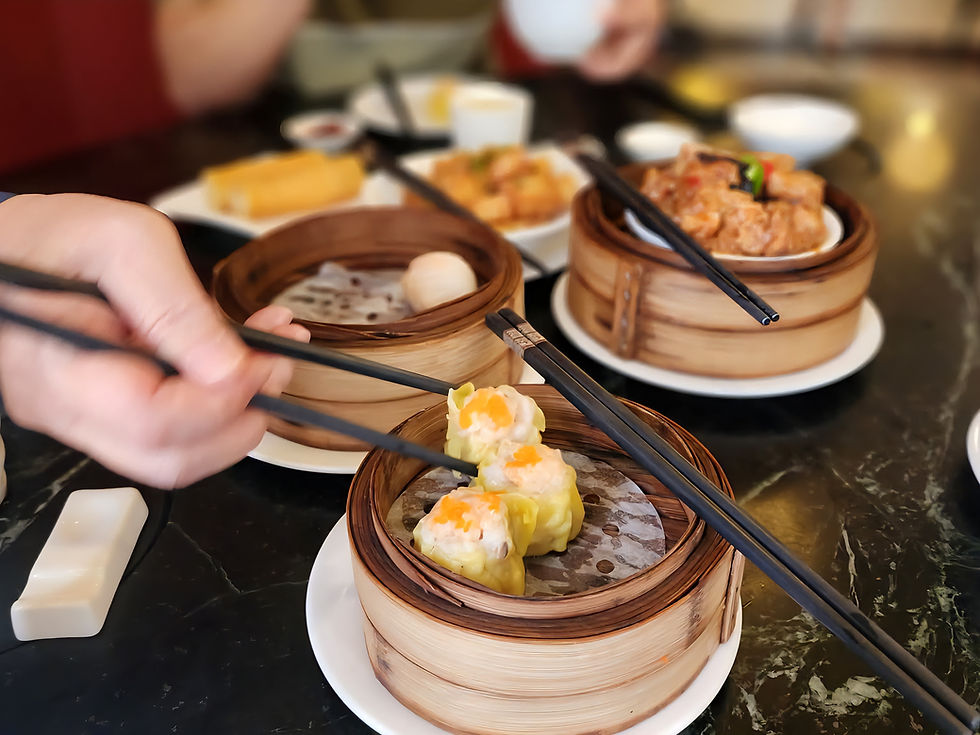The Rich History of Dim Sum
- Hanz Socials

- Jul 21
- 3 min read
Updated: Aug 5
Dim sum, which translates to "touch the heart" in Cantonese, has a history spanning over 2,500 years. This beloved culinary tradition originated in ancient China, beginning as small bite-sized meals served in teahouses along the historic Silk Road.

Origins and Evolution

The rich history of dim sum is believed to have originated during the Eastern Jin Dynasty (317-420 CE) when teahouses along the Silk Road began serving small snacks to accompany tea. These establishments primarily catered to weary travelers and merchants seeking rest and refreshment. During the Song Dynasty (960-1279 AD), dim sum became more formalized and gained popularity, particularly within teahouses.
Initially, dim sum was not meant to be a full meal but rather small bites to complement the tea-drinking experience. The Cantonese in southern China, particularly in Guangdong province, later developed dim sum into the diverse array of dishes we recognize today.
Cultural Significance
Dim sum evolved into a social dining experience called "yum cha" (drinking tea), where family and friends gather to enjoy tea and various dim sum dishes, especially during weekend brunches. This practice became deeply rooted in Chinese culture, symbolizing family unity and community bonding.
In traditional Chinese medicine, it was believed that drinking tea helped digestion and cleansed the palette. The small portions of dim sum were perfect complements to tea, creating a balanced dining experience.
Global Popularity
Dim sum gained international popularity through Chinese diaspora communities, particularly from Hong Kong and Guangdong province. Today, it has become a global culinary phenomenon for several compelling reasons:
Variety and Presentation: With hundreds of different items ranging from steamed, fried, and baked options, dim sum offers something for everyone. The beautiful presentation in bamboo steamers adds to its appeal.
Social Dining Experience: The communal nature of dim sum dining, where multiple dishes are shared among diners, creates a convivial atmosphere perfect for socializing.
Culinary Craftsmanship: Each dim sum item requires precise technique and skill, from the delicate folding of dumplings to the perfect balance of flavors, showcasing Chinese culinary artistry.
Adaptability: While maintaining traditional recipes, dim sum has also evolved to incorporate local ingredients and tastes in different regions, making it accessible to diverse palates.
Economic Value: The small portion sizes allow diners to try many different dishes without overwhelming costs, offering excellent value for money.
Modern Dim Sum

Today's dim sum continues to evolve while honoring tradition. Contemporary chefs experiment with innovative fillings, presentations, and cooking techniques while respecting the fundamental principles of dim sum preparation. From high-end restaurants to casual eateries and frozen retail options, dim sum has secured its place in global cuisine.
In Cambodia, establishments like Emperors of China and Dim Sum Emperors have helped popularize this culinary tradition, offering authentic dim sum experiences prepared by skilled Chinese culinary teams, allowing locals to enjoy this delightful aspect of Chinese gastronomy without traveling abroad.
For more information check-out their stores:
























Comments